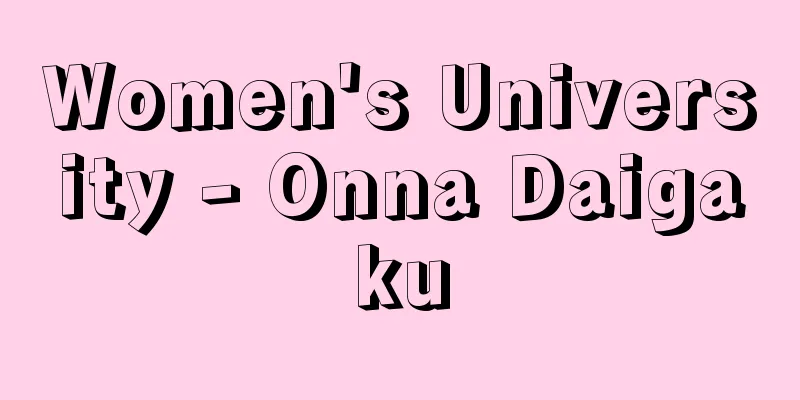Women's University - Onna Daigaku

|
A book of instruction for women that became widely available from the mid-Edo period onwards. It has been said to have been written by Kaibara Ekiken or his wife Touken, but there is no evidence to support this. It is currently believed to have been a simplified and popular version of Ekiken's "Wazoku Dojikun" volume 5, "How to Teach Girls in a Gentle Manner," published by a bookshop of the time who took advantage of the educational policies of the Kyoho era (1716-1736). The oldest surviving edition is from 1729 (the 14th year of the Kyoho era), and many different editions have been published since then, with illustrations and appendices. While Ekiken's original text divided women's education before marriage into 17 articles, this book has reduced the number of words by one third and divided it into 19 articles, first explaining the ideals of women's education and then the rules of practical life after marriage. It emphasizes feudal and servile morality, such as not having a second husband once married and submitting to one's husband as Ten (the absolute being). Masuho had a view of human equality based on reverence for heaven, which was the basis of the original text, but this was completely ignored in "Onna Daigaku." In the Meiji period, several works criticized "Onna Daigaku" and explained the role of women in modern social life, including Fukuzawa Yukichi's "Shin Onna Daigaku" (1898). [Tadashi Inoue] "Araki Kengo and Inoue Tadashi, eds., "Japanese Thought Series 34: Kaibara Ekiken and Muro Kyūsu" (1970, Iwanami Shoten)" ▽ "Ishikawa Shotarō, ed., "Women's Great Learning Collection" (Heibonsha, Toyo Bunko)" It emphasized feudal and servile morality, such as not marrying a second husband and submitting to one's husband as if he were heaven. Published in 1848 (Koka 5) A different edition from the National Diet Library . "Women's University" Source: Shogakukan Encyclopedia Nipponica About Encyclopedia Nipponica Information | Legend |
|
江戸中期以降広く普及した女子教訓書。貝原益軒(かいばらえきけん)あるいはその妻東軒(とうけん)の著とされてきたが、証拠はない。現在では益軒の『和俗童子訓』巻5の「女子ニ教ユル法」を、享保(きょうほう)(1716~36)の教化政策に便乗した当時の本屋が通俗簡略化して出版したものとされる。現存最古の版は1729年(享保14)で、その後挿絵や付録をつけ多くの異版が出た。益軒の原文が結婚前の女子教育を17か条に分けて説いたのに対し、本書は字数を3分の1に減らし19か条に分け、まず女子教育の理念、ついで結婚後の実際生活の心得を説く。一度嫁しては二夫にまみえぬこと、夫を天(絶対者)として服従すること等々、封建的隷従的道徳が強調される。益軒には敬天思想に基づく人間平等観があり、それが原文の基調となっていたが、『女大学』ではすべて捨象されている。明治に至り、『女大学』を批判し、近代社会生活における女性のあり方を説くものが、福沢諭吉(ゆきち)の『新女大学』(1898)をはじめとして数種出ている。 [井上 忠] 『荒木見悟・井上忠編『日本思想大系 34 貝原益軒・室鳩巣』(1970・岩波書店)』▽『石川松太郎編『女大学集』(平凡社・東洋文庫)』 一度嫁しては二夫にまみえぬこと、夫を天として服従すること等々、封建的隷従的道徳が強調された。1848年(弘化5)刊 異版国立国会図書館所蔵"> 『女大学』 出典 小学館 日本大百科全書(ニッポニカ)日本大百科全書(ニッポニカ)について 情報 | 凡例 |
<<: The city of women only - Onnadake no Miyako (English: The city of women only)
Recommend
"Kikigaki na nukagusa" - A narcissus of seven days
…His pen name was Tohakudo. He ran a dyeing busin...
Lachmann, Karl (Konrad Friedrich Wilhelm)
Born: March 14, 1793 in Braunschweig German lingui...
U Ottama
1880‐1939 A Burmese monk. A martyr who continued t...
Gastroenterology
…Any of the animals belonging to the class Gastro...
Gram, C. (English spelling) GramC
...By weight, the non-water content is roughly 50...
High Commissioner - High Commissioner
The title of High Commissioner is used in various...
Passiflora caerulea; passionflower
An evergreen perennial vine of the Passifloraceae ...
field emission
...secondary electron yield is sensitive to the s...
Karabag - Karabag
...The surrounding area is the Baku oil field. Th...
Lederberg, J.
...In particular, three methods have been identif...
Heaven's cave - Amenoiwayado
In Japanese mythology, Amaterasu Omikami was angry...
Ageshomon - Ageshomon
…In the case of Kanekuji, the plaintiff was requi...
Froebel - Friedrich Wilhelm August Fröbel
German educator and educational thinker. Born int...
Asuka River
A river that flows through central Nara Prefectur...
coxa
…〈The kidneys, on the other hand, are attached to...









